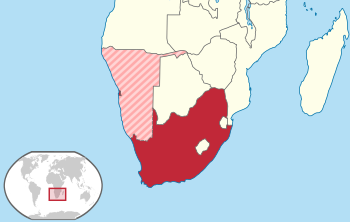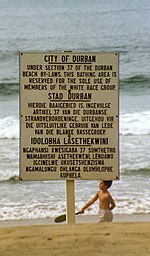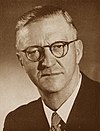First Republic of South Africa
{{#set:Bad_content=v }} {{#set:Bad_content=nn }}
{{#set:Bad_content=mergeto }} {{#set:Bad_content= }}
Republic of South Africa Republiek van Suid-Afrika (Afrikaans) | |||||||||||
|---|---|---|---|---|---|---|---|---|---|---|---|
| 1961–1994 | |||||||||||
 Location of the Republic of South Africa, with South West Africa shown as a disputed area (occupied in 1915 and administered as 5th province of the Repubic under a C-mandate from the League of Nations) | |||||||||||
| Capital | Cape Town (legislative) Pretoria (administrative) Bloemfontein (judicial) Pietermaritzburg (archival) | ||||||||||
| Largest city | Johannesburg[1][2] | ||||||||||
| Official languages | Afrikaans English | ||||||||||
| Government | Unitary parliamentary republic (1961–1984) Unitary presidential republic (1984–1994) | ||||||||||
| State President | |||||||||||
• 1961–1967 (first) | C. R. Swart | ||||||||||
• 1968–1975 | Jim Fouché | ||||||||||
• 1975–1978 | Nico Diederichs | ||||||||||
• 1978–1979 | B. J. Vorster | ||||||||||
• 1979–1984 | Marais Viljoen | ||||||||||
• 1984–1989 | P. W. Botha | ||||||||||
• 1989–1994 (last) | F. W. de Klerk | ||||||||||
| Prime Minister | |||||||||||
• 1961–1966 (first) | Hendrik Verwoerd | ||||||||||
• 1966–1978 | B. J. Vorster | ||||||||||
• 1978–1984 (last) | P. W. Botha | ||||||||||
| Legislature | Parliament | ||||||||||
| Senate | |||||||||||
| House of Assembly | |||||||||||
| History | |||||||||||
| 31 May 1961 | |||||||||||
| 3 September 1984 | |||||||||||
• Independence of Namibia | 21 March 1990 | ||||||||||
| 17 March 1992 | |||||||||||
• Transfer of Walvis Bay and Penguin Islands | 1 March 1994 | ||||||||||
| 27 April 1994 | |||||||||||
| Area | |||||||||||
| 1961 | 2,045,320 km2 (789,700 sq mi) | ||||||||||
| Population | |||||||||||
• 1961 | 18,216,000 | ||||||||||
| Currency | South African rand (1961–1994) | ||||||||||
| |||||||||||
| Today part of | |||||||||||
The First Republic of South Africa was the former government of South Africa that exist between May 1961 to April 1994. The country was unified in 1910 after British Empire granted a de facto independence via South Africa Act, 1909. The republic was declared in 1961 after the referendum in favor of abandoning the Commonwealth and became a republic. It borders South Atlantic and Indian Ocean to the south; Angola (Portuguese colony before 1975), Zimbabwe (Rhodesia before 1980), and Zambia to the north; Swaziland and Mozambique (Portuguese colony before 1975) in northeast; and its surrounds Lesotho (Basutoland before 1966) and Botswana (Bechuanaland before 1966).
The territory consist of 4 British colonies that was unified into one country; Cape Colony, Natal Colony, Orange River Colony, and Transvaal Colony. The four colonies were later unified after the British Empire passed South Africa Act of 1909 which created the Union of South Africa. The colonial administration was later transferred to provincial council. South West Africa was added to the territory later after the end of First World War administrated as League of Nations Mandate.
After the Afrikaner nationalist party, National Party rise to power in 1948, there are subsequent rise of Anglophobia within the country among Afrikaner nationalists which support secession of South Africa from the Commonwealth. The sentiment later triggered a referendum in 1961 that reserved for Whites only, which resulted the creation of the republic with majority of Afrikaners voted yes and English South Africans voted no.[3][4][5] After the referendum; Charles Robberts Swart, who was the Governor-General at that time asked Queen Elizabeth II to dismiss him from the position of Governor-General and Swart becomes the first State President of South Africa after the parliamentary vote and was inaugurated in 31 May 1961.[6]
Johannesburg was the largest city in the country while the executive capital located in Pretoria; legislative seat in Cape Town (Second largest city after Johannesburg]]; and Bloemfontein as the judicial seat. Since its transition to republic in 1961, South Africa has been ruled by white minorities and implemented the segregationist policy called apartheid which faced nationwide and international condemnation which triggered South African Border War and Internal resistance to apartheid movement. Most of the government Executive, Legislative, and Judicial branch has been dominated by white minorities. Until 1980, South Africa was one of two African nations under white minority rule along with Rhodesia (now Zimbabwe) which later was transferred to black majority rule in 1980. Namibia was given independence later in 1990, ending the 75 years of South African occupation in the region. The racial segregation policy would come to an end in 1992 with a referendum in favor of abolishing the apartheid system and the first multi-racial election was held in 1994 with Nelson Mandela as winner and first black majority president in the country.
History[edit]
Background[edit]
The beginning of South Africa can be traced by by the British Empire invasion of Dutch Cape Colony which later established the Cape Colony, British Empire would later expands further by annexing both Orange Free State and Transvaal along with Natal. Before 1909, South Africa was divided into four colonies with several failed attempt to unify the country ranging from unitary to federation from of government until the South Africa Act 1909 which gave the nominal independence for Union of South Africa with Louis Botha serving as the first Prime Minister and Viscount Gladstone as the first Governor-General. the colonial parliament replaced by provincial councils.[7] the German South West Africa was later annexed as League of Nations mandate territory from 1919 to 1990. Union of South Africa later gained its full sovereignty status after the Balfour Declaration of 1926 and Statute of Westminster 1931.
Throughout its history, South Africa has participated in both World Wars and Korean War. South Africa participated in First World War under the banner of British Empire within the Allied Power. After the end of the war, South Africe become one founding member of League of Nations after the Treaty of Versailles was signed. South Africa also participated in Second World War along with British Empire and become the member of United Nations after the end of the war. Later in 1953, South Africa participated the Korean War along with other countries under United Nations Command.
Republic Declaration[edit]

The call for republicanism has grown stronger in South Africa after the defeat of Boer Republics. After the rise of D. F. Malan and the National Party, there has been a growing republican sentiment and discontent toward The Crown rule among Afrikaner nationalists. Majority of Afrikaners who were majority group of White South Africans was in favor of cutting ties with the Commonwealth while the English who supported Jan Smuts and United Party vocally opposed the republican proposal. In 1960, British Prime Minister Harold Macmillan gave addressed the nation with the Wind of Change speech in Cape Town that criticized segregation policy in South Africa. Macmillan speech later met with opposition from Prime Minister Hendrik Verwoerd who was a staunch supporter of segregationist policy[8]
On 5 October 1960, Prime Minister Hendrik Verwoerd held referendum whether South Africa should become a republic and leave the Commonwealth as the republicanism has been long term goal of the National Party. The majority of whites consist of Afrikaners voted in favor of republic with 52.29% of votes with the opposition from the English-speaking minorities who mostly concentrated in Natal Province which only gained 47.71% of the votes. The vote was also opposed and condemned by Black South Africans who was denied vote. The African National Congress viewed the referendum as one of Verwoerd's effort to strengthen the apartheid system.[9] A year after the referendum results, Governor-General Charles Robberts Swart signed the Republican Constitution and met Queen Elizabeth II in order to dismiss his position as Governor-General of South Africa.
On 31 May 1961, The Republic of South Africa was declared. Queen Elizabeth II was dismissed as head of state and the head of state role was later replaced by State President. After the republic declaration, most symbols and public holidays referencing the British monarch was changed in the process of disassociating the republic with the Crown.[10] The election of State President were later held in 10 May 1961, shortly before the transition to republic between former Governor-General Charles Robberts Swart and former Chief Justice Henry Allan Fagan which ended with Swart victory winning 66.19% of the votes. Swart were later inaugurated on the same day republic was declared as the first State President of South Africa.
Apartheid[edit]

South Africa implemented the segregationist system called apartheid that was implemented in South Africa]] and South West Africa from 1949 to 1992. The apartheid system has been implemented in 1948 after the victory of Afrikaner nationalist politician D.F. Malan in 1948 South African general election. During his tenure as Prime Minister, Malan passed several racial segregation law in order to ensure white domination in politics and economy. In 1950, Malan government signed the Population Registration Act that classify South African nationals into four racial classifications; Black, White, Coloureds (including Cape Coloureds, Cape Malays, and Chinese), and Indians (South Asians hailed from British Raj). In 1953, Malan signed the Reservation of Separate Amenities Act which segregates public services, public transports, and other premises reserved for certain races within the country. Malan also implemented the Pass laws that segregates the blacks and the whites further. The law has met further domestic resistance demanding the end of the apartheid system ranging from protests, mass strikes, and even guerilla warfare. The peaceful movement has reached its boiling point after Sharpeville massacre in front of the police station in Sharpeville township when 7,000 protesters gathered to protest against the pass law, this even marks the beginning of South Africa's departure from Commonwealth and international isolation.

After the removal of Dominion, Prime Minister Hendrik Verwoerd, who was staunch supporter of apartheid policy expanded the apartheid policy further calling it as "good neighbourliness policy". Due to his large role implementing apartheid policy, he was dubbed as "Architect of Apartheid". During his tenure, Verwoerd signed three legislative act;[11] Promotion of Bantu Self-government Act which marks the creation of Bantustan, Promotion of Bantu Self-government Act which allowed South African businesses to invest in Bantustan, and Extension of University Education Act which bar non-whites to enroll in certain universities. Verwoerd policies has met condemnation from the international community. The United Nations later passed the United Nations General Assembly Resolution 1761 after Secretary-General Dag Hammarskjöld visit to Pretoria.[12] The United States and United Kingdom government implemented arms embargo as protest to the apartheid policy.
Border War[edit]
End of Apartheid[edit]
Government and Politics[edit]
From 1961 to 1984, South Africa adopted Westminster model Parliamentary system. the State President were elected by the parliament while the Prime Minister was elected by election. The State President serves as ceremonial head of state and required advice from the Cabinet while the head of government position was largely held by the Prime Minister.
The legislative branch of the government was vested by the Parliament of South Africa which consist of House of Assembly and the Senate. The House of Assembly consist of 150 members and was elected for five years term with First-past-the-post voting. The vote was reserved for whites only with six members voted by White Namibians in South West Africa and four Coloureds voters from Cape Province. The assembly system has undergo several changes for three times, with the following changes were made later:
- Coloured representation was ended in 1968, leaving both the Senate and the House of Assembly representing white voters only.
- South West Africa ceased to be represented in Parliament from 1977.[13]
- The Senate was abolished in 1981, changing Parliament to a unicameral legislature
While the senate consists of eight people, consist of two representative from the provinces nominated by the state president. Four senators from South West Africa was also nominated by state president until 1977. A Coloured senator was also nominated to represent the Cape Coloureds community of the Cape Province until 1970. The senate election was jointly held with the House of Assembly election with elected senators serve five years term.
Divisions[edit]
The First Republic of South Africa were divided into four provinces with one mandate territory of South West Africa that were governed as the de-facto "fifth province" of South Africa. Each provinces were administrated by Province Administrator appointed by the central government.
| Province | Capital | Peak population | Location |
|---|---|---|---|
| Cape of Good Hope (1910–1994) | Cape Town | 6,125,335 | |
| Natal (1910–1994) | Pietermaritzburg | 2,430,753 | |
| Orange Free State (1910–1994) | Bloemfontein | 2,193,062 | |
| Transvaal (1910–1994) | Pretoria | 9,491,265 | |
| Mandates | Capital | Peak population | Location |
| South-West Africa | Windhoek | 1,415,000 |
South Africa also implemented a homeland system called bantustan which are autonomous areas and administrated separately from the four provinces. The self-governing territories were created after the Promotion of Bantu Self-government Act, 1959 was passed by Prime Minister Hendrik Verwoerd. Among the self-governing bantustans, four territories of Transkei, Venda, Bophuthatswana, and Ciskei (TVBC states) were granted nominal independence which were not recognized by the international communities.
| Bantustan | Capital | Tribe |
|---|---|---|
| Umtata | Xhosa | |
| Tswana | ||
|
Venda | |
| Xhosa |
Economy[edit]
South Africa have vast amount of mineral resources like old, diamond, coal, iron ore and platinum and also have very vast agricultural land. During the apartheid era, South Africa has faced multiple embargoes from the western countries, most notably the United States[14] and United Kingdom. The embargo has caused the South African manufacturers struggle to import their products overseas due to sanctions. It also caused the local business have to cater the local market in order to keep the economy running[15]
Military[edit]
Culture[edit]
Media[edit]
Sport[edit]
Demographics[edit]
Foreign Relations[edit]
Africa[edit]
Asia[edit]
The apartheid government has maintained relations with 3 Eastern Asian nations, most particularly Japan, Taiwan, and Hong Kong (British overseas territories at that time). From 1960s, the Japanese are actively trading in South Africa despite sanctions from United Nations due to its apartheid policy. This resulted Japanese are granted the honorary whites status by the apartheid government. After the United Nations General Assembly Resolution 2758, South African government began to pursue more friendlier relationship with Kuomintang regime in Taiwan due to its shared struggle. The good relations would later make the government to designate the trade immigrants from Taiwan honorary whites status. The government also offered South Koreans a honorary whites status, but the South Koreans government refused and denounced the apartheid system in the country.
Western World[edit]
After South Africa severed ties with the Commonwealth, South African relationship with the western world started to sour. The government of United Kingdom denounced the apartheid system that were practiced by the government and issued arms embargo.
International Condemnation[edit]
References[edit]
- ↑ travelfilmarchive (8 November 2012). "The Union of South Africa, 1956" – via YouTube.
- ↑ darren lennox (23 February 2017). "British Empire: The British Colony Of The Union Of South Africa 1956" – via YouTube.
- ↑ South Africa: A War Won, Time, 9 June 1961
- ↑ The Statesman's Year-Book 1975-76, J. Paxton, 1976, Macmillan, page 1289
- ↑ "Hendrik Frensch Verwoerd". South African History Online. Retrieved 9 March 2013.
On 5 October 1960 a referendum was held in which White voters were asked "Do you support a republic for the Union?" — 52 percent voted 'Yes'.
- ↑ South Africa & Apartheid, Robert W. Peterson, Facts on File, 1975, page 84
- ↑ South Africa Act, 1909, Part V, sections 68 to 94.
- ↑ The White Tribe of Africa, David Harrison, University of California Press, 1983, page 163
- ↑ The Lion and the Springbok: Britain and South Africa Since the Boer War, Ronald Hyam, Peter Henshaw, Cambridge University Press, 2003, page 301
- ↑ Justice of the Peace and Local Government Review, Volume 125, Justice of the Peace Limited, 1961, page 1875
- ↑ "Apartheid Legislation in South Africa". Africanhistory.about.com. 13 April 2012. Retrieved 6 September 2012.
- ↑ http://richardknight.homestead.com/files/armsembargo.htm
- ↑ SOUTH AFRICA Date of Elections: 30 November 1977, Inter-Parliamentary-Union
- ↑ "Sanctions Against South Africa (1986)". United States Embassy. 1986.
- ↑ "South Africa's Economic History". South African Market Insights. 20 June 2019. Retrieved 23 May 2021.
Separate article for 1961–1994 South Africa[edit]
{{#set:Technical tag=Article from Wikipedia}}{{#set:priority= }} {{#set:PageName=First_Republic_of_South_Africa }}
This article "First Republic of South Africa" is from Wikipedia. The list of its authors can be seen in its historical and/or the page Edithistory:First Republic of South Africa. Articles copied from Draft Namespace on Wikipedia could be seen on the Draft Namespace of Wikipedia and not main one.{{#set:Article=true}}




